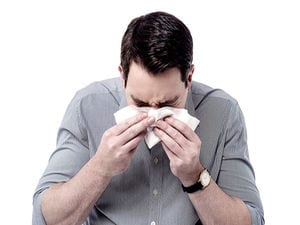
FRIDAY, Jan. 26, 2018 (HealthDay News) — This flu season is shaping up as one of the nastiest in years, and it isn’t showing any signs of easing, U.S. health officials said Friday.
Every state except Hawaii continues to experience widespread activity, with the more virulent H3N2 strain continuing to dominate, according to the latest weekly update from the U.S. Centers for Disease Control and Prevention.
After the holidays, “flu activity became widespread within almost all states and jurisdictions at the same time,” Dr. Daniel Jernigan, director of the CDC’s influenza division, said during a media briefing Friday morning.
“We often see different parts of the country light up at different times, but for the past three weeks the entire country has been experiencing lots of flu all at the same time,” Jernigan noted.
And the flu that people have been catching has been more severe, he added, with hospitalizations “tracking at the same level as 2014-15, which was the last high-severity season we had.” That was also a season when H3N2 was the dominant strain.
At this point, “6.6 percent of clinic and ED visits are flu-related,” Jernigan said. “This is the highest level of activity recorded since the 2009 H1N1 pandemic, which peaked at 7.7 percent.”
And flu-linked hospitalization rates continued to rise, according to the latest CDC update — from 13.7 per 100,000 people three weeks ago to 41.9 per 100,000 people as of Jan. 20.
Flu patients over 65 years of age are most prone to needing hospital care, the report showed, but rates are also getting very high for people between the ages of 50 and 64.
“This represents a change from what we’ve seen in the past,” Jernigan said. “In past seasons, young children have been the next most impacted group.”
But, “baby boomers have higher rates [of hospitalization] than their grandchildren right now,” he added.
That doesn’t mean the youngest Americans aren’t still at risk. Thirty-seven infants or small children have already died from flu this season, with seven of these tragedies occurring over the latest week of reporting.
“We expect there will be more reports of pediatric deaths, similar to what we’ve seen in more severe seasons,” Jernigan said.
And the end to all this misery may be far off: “We’re about halfway there this season,” Jernigan noted. “We have several more weeks of flu to go.”
The unique characteristics of the H3N2 strain make that misery even more pronounced, officials explained.
The strain first showed up 50 years ago, Jernigan said.
“Since that time, that virus has continued to change. It’s getting down a path now where it’s gone through lots of changes, but it’s amazing how much it is able to evade the human immune system still,” he added.
“This particular virus has lower vaccine effectiveness,” he said. “The exact reasons for that are still being figured out.”
Despite the severity of the season, the American Lung Association says there are things you can do to avoid being stricken by the virus.
“The flu is more than just ‘a bad cold.’ It’s a serious respiratory illness that’s easily spread from person to person, usually when the person with the flu coughs or sneezes,” said Dr. Norman Edelman, senior scientific advisor for the American Lung Association.
“Symptoms of the flu include fever, cough, weakness, aches and pains,” Edelman said in a lung association news release. “If you have asthma or other lung diseases, you are at higher risk of developing complications from the flu.”
There are a number of ways people can protect themselves and others. They include:
- Get a flu shot. Though this year’s vaccine isn’t a perfect match for the viruses in circulation, it’s still the best way to protect against infection. And some protection is better than none. Flu season may not end until May. The flu shot will remain effective for roughly six months.
- Seek medical attention. People who develop flu-like symptoms should see a doctor right away. Antiviral medications can help ease symptoms, but these drugs are most effective if taken within 48 hours of getting sick.
- Don’t spread the misery. If you get the flu, take steps to prevent passing the infection onto others. Sick people should cover their mouth and nose with a tissue when coughing or sneezing. Hands should be washed frequently. People should avoid touching their eyes, nose or mouth, particularly if their hands aren’t clean. Be sure to disinfect possibly contaminated surfaces and objects. Anyone with the flu should stay home and not go to work or school for about a week. Once flu symptoms appear, people are contagious for five to seven days.
More information
The U.S. Centers for Disease Control and Prevention has more about the flu.
